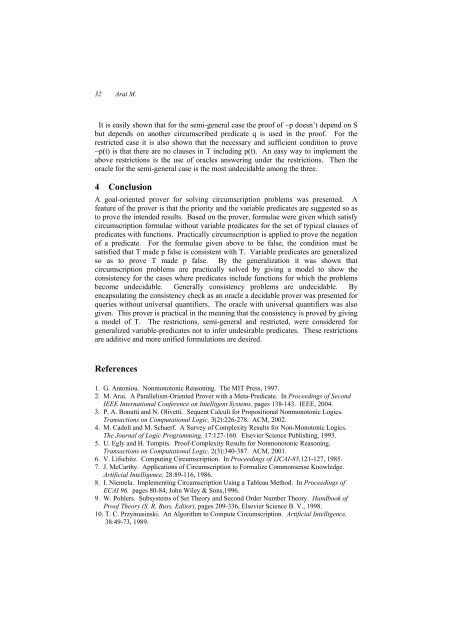Advances in Artificial Intelligence Theory - MICAI - Mexican ...
Advances in Artificial Intelligence Theory - MICAI - Mexican ...
Advances in Artificial Intelligence Theory - MICAI - Mexican ...
You also want an ePaper? Increase the reach of your titles
YUMPU automatically turns print PDFs into web optimized ePapers that Google loves.
It is easily shown that for the semi-general case the proof of ~p doesn’t depend on S<br />
but depends on another circumscribed predicate q is used <strong>in</strong> the proof. For the<br />
restricted case it is also shown that the necessary and sufficient condition to prove<br />
~p(t) is that there are no clauses <strong>in</strong> T <strong>in</strong>clud<strong>in</strong>g p(t). An easy way to implement the<br />
above restrictions is the use of oracles answer<strong>in</strong>g under the restrictions. Then the<br />
oracle for the semi-general case is the most undecidable among the three.<br />
4 Conclusion<br />
A goal-oriented prover for solv<strong>in</strong>g circumscription problems was presented. A<br />
feature of the prover is that the priority and the variable predicates are suggested so as<br />
to prove the <strong>in</strong>tended results. Based on the prover, formulae were given which satisfy<br />
circumscription formulae without variable predicates for the set of typical clauses of<br />
predicates with functions. Practically circumscription is applied to prove the negation<br />
of a predicate. For the formulae given above to be false, the condition must be<br />
satisfied that T made p false is consistent with T. Variable predicates are generalized<br />
so as to prove T made p false. By the generalization it was shown that<br />
circumscription problems are practically solved by giv<strong>in</strong>g a model to show the<br />
consistency for the cases where predicates <strong>in</strong>clude functions for which the problems<br />
become undecidable. Generally consistency problems are undecidable. By<br />
encapsulat<strong>in</strong>g the consistency check as an oracle a decidable prover was presented for<br />
queries without universal quantifiers. The oracle with universal quantifiers was also<br />
given. This prover is practical <strong>in</strong> the mean<strong>in</strong>g that the consistency is proved by giv<strong>in</strong>g<br />
a model of T. The restrictions, semi-general and restricted, were considered for<br />
generalized variable-predicates not to <strong>in</strong>fer undesirable predicates. These restrictions<br />
are additive and more unified formulations are desired.<br />
References<br />
1. G. Antoniou. Nonmonotonic Reason<strong>in</strong>g. The MIT Press, 1997.<br />
2. M. Arai. A Parallelism-Oriented Prover with a Meta-Predicate. In Proceed<strong>in</strong>gs of Second<br />
IEEE International Conference on Intelligent Systems, pages 138-143. IEEE, 2004.<br />
3. P. A. Bonatti and N. Olivetti. Sequent Calculi for Propositional Nonmonotonic Logics.<br />
Transactions on Computational Logic, 3(2):226-278. ACM, 2002.<br />
4. M. Cadoli and M. Schaerf. A Survey of Complexity Results for Non-Monotonic Logics.<br />
The Journal of Logic Programm<strong>in</strong>g, 17:127-160. Elsevier Science Publish<strong>in</strong>g, 1993.<br />
5. U. Egly and H. Tompits. Proof-Complexity Results for Nonmonotonic Reason<strong>in</strong>g.<br />
Transactions on Computational Logic, 2(3):340-387. ACM, 2001.<br />
6. V. Lifschitz. Comput<strong>in</strong>g Circumscription. In Proceed<strong>in</strong>gs of IJCAI-85,121-127, 1985.<br />
7. J. McCarthy. Applications of Circumscription to Formalize Commonsense Knowledge.<br />
<strong>Artificial</strong> <strong>Intelligence</strong>, 28:89-116, 1986.<br />
8. I. Niemela. Implement<strong>in</strong>g Circumscription Us<strong>in</strong>g a Tableau Method. In Proceed<strong>in</strong>gs of<br />
ECAI 96. pages 80-84, John Wiley & Sons,1996.<br />
9. W. Pohlers. Subsystems of Set <strong>Theory</strong> and Second Order Number <strong>Theory</strong>. Handbook of<br />
Proof <strong>Theory</strong> (S. R. Buss, Editor), pages 209-336, Elsevier Science B. V., 1998.<br />
10. T. C. Przymus<strong>in</strong>ski. An Algorithm to Compute Circumscription. <strong>Artificial</strong> <strong>Intelligence</strong>,<br />
38:49-73, 1989.

















